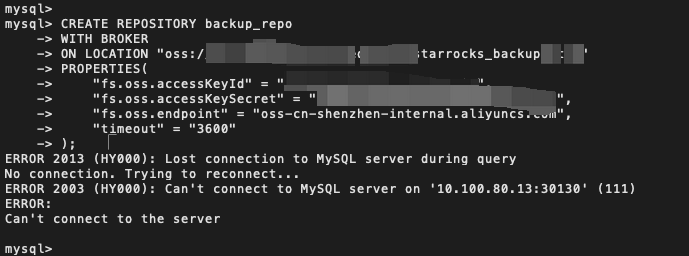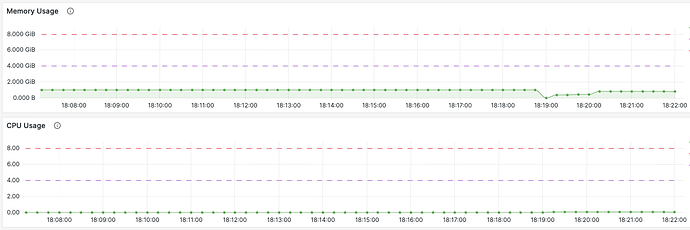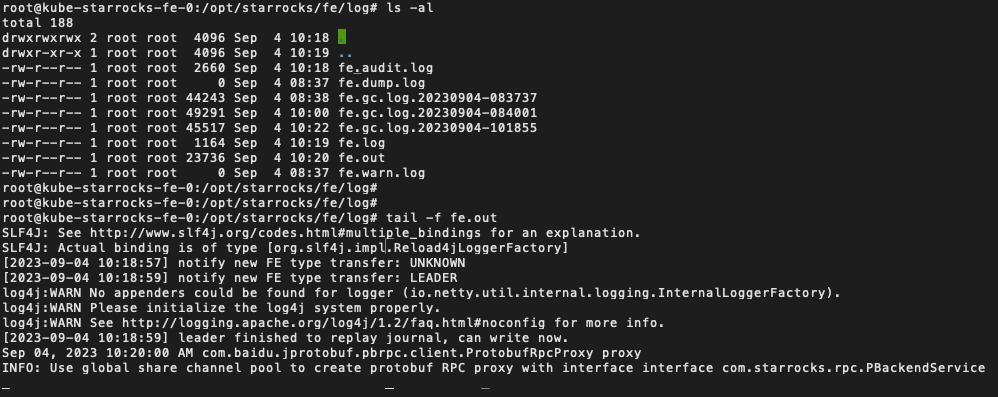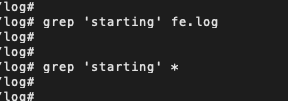【详述】chart版本1.6.1安装的服务,远程仓库类型为oss,计划通过 CREATE REPOSITORY备份数据,备份数据,但在执行命令时会导致fe重启,并且fe和be都查不到任何报错,查看监控指标也都正常,k8s events显示liveness检测失败:
91s Warning Unhealthy pod/kube-starrocks-fe-0 Readiness probe failed: Get “http://10.100.80.31:8030/api/health”: read tcp 10.100.80.13:56778->10.100.80.31:8030: read: connection reset by peer
所执行命令:
CREATE REPOSITORY backup_repo
WITH BROKER
ON LOCATION “oss://my-bucket/starrocks_backup”
PROPERTIES(
“fs.oss.accessKeyId” = “my-ak”,
“fs.oss.accessKeySecret” = “my-sk”,
“fs.oss.endpoint” = “oss-cn-shenzhen-internal.aliyuncs.com”,
“timeout” = “3600”
);
【背景】通过helm安装的starrocks-fe和starrocks-be,安装时chart版本为1.6.1,根据业务实际情况自定义了部分values内容,由于该版本没有初始化密码的设置,导致存在一定的安全隐患,所以改用1.7.1版本chart新建了一套集群,但是1.7.1更改了pvc的相关机制,原pvc无法继续在新集群使用,只能进行备份和恢复的方式,1.6.1版本的values.yaml如下:
# Default values for kube-starrocks.
# This is a YAML-formatted file.
# Declare variables to be passed into your templates.
global:
rbac:
create: true
# set the starrockscluster CRD version. from operator v1.6 we have supported v1 CRD and as default CRD version. but the v1alpha1 also supported.
# in future v1alpha1 as verify CRD, when the ability is stable will be added into v1.
# supported value: v1, v1alpha1
crdVersion: v1
# the starrockscluster crd' name.
nameOverride: ""
starrocksOperator:
# provide a name for operator deployment.
enabled: true
namespaceOverride: ""
image:
# image sliced by "repository:tag"
repository: starrocks/operator
tag: latest
resources:
limits:
cpu: 500m
memory: 200Mi
requests:
cpu: 500m
memory: 200Mi
# deploy a starrocks cluster
starrocksCluster:
# Provide a name for starprocks cluster
name: ""
namespace: ""
# annotations for starrocks cluster
annotations: {}
labels:
object: starrocks
# specify the cn deploy or not.
enabledCn: false
# spec to deploy fe.
starrocksFESpec:
# Number of replicas to deploy for a fe statefulset.
replicas: 1
image:
# image sliced by "repository:tag"
repository: starrocks/fe-ubuntu
tag: 2.5.9
# add annotations for fe pods. example, if you want to config monitor for datadog, you can config the annotations. etc...
annotations: {}
# A special supplemental group that applies to all containers in a pod. Some volume types allow the Kubelet to change the ownership of that volume to be owned by the pod:
# Ref: https://kubernetes.io/docs/tasks/configure-pod-container/security-context/#configure-volume-permission-and-ownership-change-policy-for-pods
fsGroup: 0
# specify the service name and port config and serviceType
# the service type refer https://kubernetes.io/docs/concepts/services-networking/service/#publishing-services-service-types
service:
# the fe service type, only supported ClusterIP, NodePort, LoadBalancer, ExternalName
type: "NodePort"
targetPort: 9030
# the loadbalancerIP for static ip config when the type=LoadBalancer and loadbalancerIp is not empty.
# loadbalancerIP: ""
# contains the secret name
imagePullSecrets: []
# - name: "image-pull-secret"
# serviceAccount for fe access cloud service.
serviceAccount: ""
# If specified, the pod's nodeSelector,displayName="Map of nodeSelectors to match when scheduling pods on nodes"
# Ref: https://kubernetes.io/docs/concepts/scheduling-eviction/assign-pod-node/#nodeselector
nodeSelector: {}
# beta.kubernetes.io/arch: amd64
# beta.kubernetes.io/os: linux
# the pod labels for user select or classify pods.
podLabels: {}
## hostAliases allows adding entries to /etc/hosts inside the containers
hostAliases: []
# - ip: "127.0.0.1"
# hostnames:
# - "example.com"
# Additional fe container environment variables
# You specify this manually like you would a raw deployment manifest.
# This means you can bind in environment variables from secrets.
# Ref: https://kubernetes.io/docs/tasks/inject-data-application/define-environment-variable-container/
feEnvVars: []
# e.g. static environment variable:
# - name: DEMO_GREETING
# value: "Hello from the environment"
#
# e.g. secret environment variable:
# - name: USERNAME
# valueFrom:
# secretKeyRef:
# name: mysecret
# key: username
# Pod affinity
affinity: {}
# nodeAffinity:
# requiredDuringSchedulingIgnoredDuringExecution:
# nodeSelectorTerms:
# - matchFields:
# - key: metadata.name
# operator: In
# values:
# - target-host-name
# Node tolerations for fe pod scheduling to nodes with taints
# Ref: https://kubernetes.io/docs/concepts/configuration/assign-pod-node/
tolerations: []
# - key: "key"
# operator: "Equal|Exists"
# value: "value"
# effect: "NoSchedule|PreferNoSchedule|NoExecute(1.6 only)"
resources:
requests:
cpu: 4
memory: 4Gi
limits:
cpu: 8
memory: 8Gi
# fe storageSpec for persistent meta data.
storageSpec:
# the name of volume for mount. if not will use emptyDir.
name: "starrocks-fe"
# the storageClassName represent the used storageclss name. if not set will use k8s cluster default storageclass.
# you must set name when you set storageClassName
storageClassName: "alibabacloud-cnfs-nas"
#the persistent volume size default 1 Gi.
storageSize: 1Gi
# the config for start fe. the base information as follows.
config: |
LOG_DIR = ${STARROCKS_HOME}/log
DATE = "$(date +%Y%m%d-%H%M%S)"
JAVA_OPTS="-Dlog4j2.formatMsgNoLookups=true -Xmx8192m -XX:+UseMembar -XX:SurvivorRatio=8 -XX:MaxTenuringThreshold=7 -XX:+PrintGCDateStamps -XX:+PrintGCDetails -XX:+UseConcMarkSweepGC -XX:+UseParNewGC -XX:+CMSClassUnloadingEnabled -XX:-CMSParallelRemarkEnabled -XX:CMSInitiatingOccupancyFraction=80 -XX:SoftRefLRUPolicyMSPerMB=0 -Xloggc:${LOG_DIR}/fe.gc.log.$DATE"
JAVA_OPTS_FOR_JDK_9="-Dlog4j2.formatMsgNoLookups=true -Xmx8192m -XX:SurvivorRatio=8 -XX:MaxTenuringThreshold=7 -XX:+CMSClassUnloadingEnabled -XX:-CMSParallelRemarkEnabled -XX:CMSInitiatingOccupancyFraction=80 -XX:SoftRefLRUPolicyMSPerMB=0 -Xlog:gc*:${LOG_DIR}/fe.gc.log.$DATE:time"
http_port = 8030
rpc_port = 9020
query_port = 9030
edit_log_port = 9010
mysql_service_nio_enabled = true
sys_log_level = INFO
## spec for compute node, compute node provide compute function.
starrocksCnSpec:
image:
# image sliced by "repository:tag"
repository: starrocks/cn-ubuntu
tag: 2.5.9
# serviceAccount for cn access cloud service.
#serviceAccount: starrocks
# add annotations for cn pods. example, if you want to config monitor for datadog, you can config the annotations. etc...
annotations: {}
# A special supplemental group that applies to all containers in a pod. Some volume types allow the Kubelet to change the ownership of that volume to be owned by the pod:
# Ref: https://kubernetes.io/docs/tasks/configure-pod-container/security-context/#configure-volume-permission-and-ownership-change-policy-for-pods
fsGroup: 0
# specify the service name and port config and serviceType
# the service type refer https://kubernetes.io/docs/concepts/services-networking/service/#publishing-services-service-types
service:
# the fe service type, only supported ClusterIP, NodePort, LoadBalancer, ExternalName
type: "ClusterIP"
# targetPort: 9030
# the loadbalancerIP for static ip config when the type=LoadBalancer and loadbalancerIp is not empty.
loadbalancerIP: ""
# contains the secret name
imagePullSecrets: []
# - name: "image-pull-secret"
# serviceAccount for fe access cloud service.
serviceAccount: ""
# If specified, the pod's nodeSelector,displayName="Map of nodeSelectors to match when scheduling pods on nodes"
# Ref: https://kubernetes.io/docs/concepts/scheduling-eviction/assign-pod-node/#nodeselector
nodeSelector: {}
# beta.kubernetes.io/arch: amd64
# beta.kubernetes.io/os: linux
# the pod labels for user select or classify pods.
podLabels: {}
## hostAliases allows adding entries to /etc/hosts inside the containers
hostAliases: []
# - ip: "127.0.0.1"
# hostnames:
# - "example.com"
# Additional cn container environment variables
# You specify this manually like you would a raw deployment manifest.
# This means you can bind in environment variables from secrets.
# Ref: https://kubernetes.io/docs/tasks/inject-data-application/define-environment-variable-container/
cnEnvVars: []
# e.g. static environment variable:
# - name: DEMO_GREETING
# value: "Hello from the environment"
# e.g. secret environment variable:
# - name: USERNAME
# valueFrom:
# secretKeyRef:
# name: mysecret
# key: username
# Pod affinity
affinity: {}
# nodeAffinity:
# requiredDuringSchedulingIgnoredDuringExecution:
# nodeSelectorTerms:
# - matchFields:
# - key: metadata.name
# operator: In
# values:
# - target-host-name
# Node tolerations for cn pod scheduling to nodes with taints
# Ref: https://kubernetes.io/docs/concepts/configuration/assign-pod-node/
tolerations: []
# - key: "key"
# operator: "Equal|Exists"
# value: "value"
# effect: "NoSchedule|PreferNoSchedule|NoExecute(1.6 only)"
autoScalingPolicy: {}
# maxReplicas: 10
# minReplicas: 1
# hpaPolicy:
# metrics:
# - type: Resource
# resource:
# name: memory
# target:
# averageUtilization: 30
# type: Utilization
# - type: Resource
# resource:
# name: cpu
# target:
# averageUtilization: 30
# type: Utilization
# behavior:
# scaleUp:
# policies:
# - type: Pods
# value: 1
# periodSeconds: 10
# scaleDown:
# selectPolicy: Disabled
# define resources requests and limits for cn pods.
resource:
limits:
cpu: 8
memory: 8Gi
requests:
cpu: 4
memory: 8Gi
# the config start for cn, the base information as follows.
config: |
sys_log_level = INFO
# ports for admin, web, heartbeat service
thrift_port = 9060
webserver_port = 8040
heartbeat_service_port = 9050
brpc_port = 8060
## spec for component be, be provide storage and compute function.
starrocksBeSpec:
## Number of replicas to deploy for a be statefulset.
replicas: 1
image:
# image sliced by "repository:tag"
repository: starrocks/be-ubuntu
tag: 2.5.9
## serviceAccount for be access cloud service.
#serviceAccount: starrocks
# add annotations for be pods. example, if you want to config monitor for datadog, you can config the annotations. etc...
annotations: {}
# A special supplemental group that applies to all containers in a pod. Some volume types allow the Kubelet to change the ownership of that volume to be owned by the pod:
# Ref: https://kubernetes.io/docs/tasks/configure-pod-container/security-context/#configure-volume-permission-and-ownership-change-policy-for-pods
fsGroup: 0
# specify the service name and port config and serviceType
# the service type refer https://kubernetes.io/docs/concepts/services-networking/service/#publishing-services-service-types
service:
# the fe service type, only supported ClusterIP, NodePort, LoadBalancer, ExternalName
type: "ClusterIP"
# targetPort: 9050
# the loadbalancerIP for static ip config when the type=LoadBalancer and loadbalancerIp is not empty.
# loadbalancerIP: ""
# contains the secret name
imagePullSecrets: []
# - name: "image-pull-secret"
# serviceAccount for fe access cloud service.
serviceAccount: ""
# If specified, the pod's nodeSelector,displayName="Map of nodeSelectors to match when scheduling pods on nodes"
# Ref: https://kubernetes.io/docs/concepts/scheduling-eviction/assign-pod-node/#nodeselector
nodeSelector: {}
# beta.kubernetes.io/arch: amd64
# beta.kubernetes.io/os: linux
# the pod labels for user select or classify pods.
podLabels: {}
## hostAliases allows adding entries to /etc/hosts inside the containers
hostAliases: []
# - ip: "127.0.0.1"
# hostnames:
# - "example.com"
# Additional be container environment variables
# You specify this manually like you would a raw deployment manifest.
# This means you can bind in environment variables from secrets.
#
# Ref: https://kubernetes.io/docs/tasks/inject-data-application/define-environment-variable-container/
beEnvVars: []
# e.g. static environment variable:
# - name: DEMO_GREETING
# value: "Hello from the environment"
#
# e.g. secret environment variable:
# - name: USERNAME
# valueFrom:
# secretKeyRef:
# name: jXmivBDAX9skaHma
# key: root
## Pod affinity
affinity: {}
# nodeAffinity:
# requiredDuringSchedulingIgnoredDuringExecution:
# nodeSelectorTerms:
# - matchFields:
# - key: metadata.name
# operator: In
# values:
# - target-host-name
# Node tolerations for be pod scheduling to nodes with taints
# Ref: https://kubernetes.io/docs/concepts/configuration/assign-pod-node/
tolerations: []
# - key: "key"
# operator: "Equal|Exists"
# value: "value"
# effect: "NoSchedule|PreferNoSchedule|NoExecute(1.6 only)"
resource:
requests:
cpu: 4
memory: 4Gi
limits:
cpu: 8
memory: 8Gi
## specify storageclass name and request size.
storageSpec:
# the name of volume for mount. if not will use emptyDir.
name: "starrocks-be"
# the storageClassName represent the used storageclss name. if not set will use k8s cluster default storageclass.
# you must set name when you set storageClassName
storageClassName: "alibabacloud-cnfs-nas"
storageSize: 100Gi
# the config for start be. the base information as follows.
config: |
be_port = 9060
webserver_port = 8040
heartbeat_service_port = 9050
brpc_port = 8060
sys_log_level = INFO
default_rowset_type = beta
【业务影响】root账号为空密码
【StarRocks版本】2.5.9
【集群规模】1fe + 1be
【机器信息】Pod配置:8C8G200Mbps
【联系方式】iamvea@163.com
【附件】

重启:
监控:
日志:




